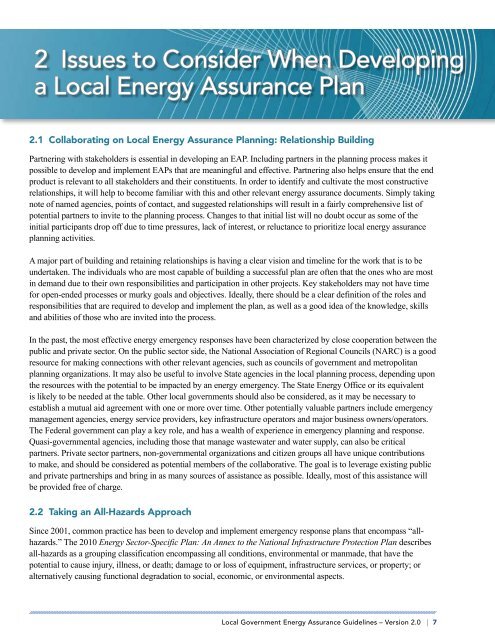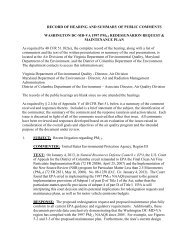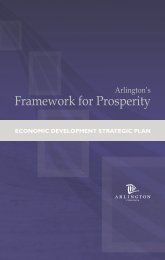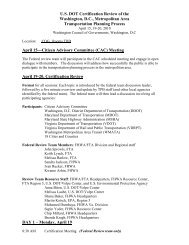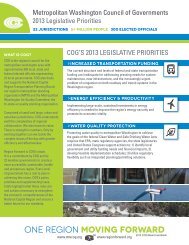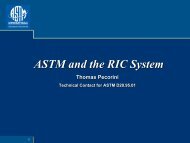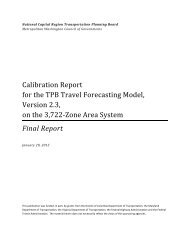PTI Local Government Energy Assurance Guidelines - Metropolitan ...
PTI Local Government Energy Assurance Guidelines - Metropolitan ...
PTI Local Government Energy Assurance Guidelines - Metropolitan ...
Create successful ePaper yourself
Turn your PDF publications into a flip-book with our unique Google optimized e-Paper software.
2 Issues to Consider When Developing<br />
a <strong>Local</strong> <strong>Energy</strong> <strong>Assurance</strong> Plan<br />
2.1 Collaborating on <strong>Local</strong> <strong>Energy</strong> <strong>Assurance</strong> Planning: Relationship Building<br />
Partnering with stakeholders is essential in developing an EAP. Including partners in the planning process makes it<br />
possible to develop and implement EAPs that are meaningful and effective. Partnering also helps ensure that the end<br />
product is relevant to all stakeholders and their constituents. In order to identify and cultivate the most constructive<br />
relationships, it will help to become familiar with this and other relevant energy assurance documents. Simply taking<br />
note of named agencies, points of contact, and suggested relationships will result in a fairly comprehensive list of<br />
potential partners to invite to the planning process. Changes to that initial list will no doubt occur as some of the<br />
initial participants drop off due to time pressures, lack of interest, or reluctance to prioritize local energy assurance<br />
planning activities.<br />
A major part of building and retaining relationships is having a clear vision and timeline for the work that is to be<br />
undertaken. The individuals who are most capable of building a successful plan are often that the ones who are most<br />
in demand due to their own responsibilities and participation in other projects. Key stakeholders may not have time<br />
for open-ended processes or murky goals and objectives. Ideally, there should be a clear definition of the roles and<br />
responsibilities that are required to develop and implement the plan, as well as a good idea of the knowledge, skills<br />
and abilities of those who are invited into the process.<br />
In the past, the most effective energy emergency responses have been characterized by close cooperation between the<br />
public and private sector. On the public sector side, the National Association of Regional Councils (NARC) is a good<br />
resource for making connections with other relevant agencies, such as councils of government and metropolitan<br />
planning organizations. It may also be useful to involve State agencies in the local planning process, depending upon<br />
the resources with the potential to be impacted by an energy emergency. The State <strong>Energy</strong> Office or its equivalent<br />
is likely to be needed at the table. Other local governments should also be considered, as it may be necessary to<br />
establish a mutual aid agreement with one or more over time. Other potentially valuable partners include emergency<br />
management agencies, energy service providers, key infrastructure operators and major business owners/operators.<br />
The Federal government can play a key role, and has a wealth of experience in emergency planning and response.<br />
Quasi-governmental agencies, including those that manage wastewater and water supply, can also be critical<br />
partners. Private sector partners, non-governmental organizations and citizen groups all have unique contributions<br />
to make, and should be considered as potential members of the collaborative. The goal is to leverage existing public<br />
and private partnerships and bring in as many sources of assistance as possible. Ideally, most of this assistance will<br />
be provided free of charge.<br />
2.2 Taking an All-Hazards Approach<br />
Since 2001, common practice has been to develop and implement emergency response plans that encompass “allhazards.”<br />
The 2010 <strong>Energy</strong> Sector-Specific Plan: An Annex to the National Infrastructure Protection Plan describes<br />
all-hazards as a grouping classification encompassing all conditions, environmental or manmade, that have the<br />
potential to cause injury, illness, or death; damage to or loss of equipment, infrastructure services, or property; or<br />
alternatively causing functional degradation to social, economic, or environmental aspects.<br />
<strong>Local</strong> <strong>Government</strong> <strong>Energy</strong> <strong>Assurance</strong> <strong>Guidelines</strong> – Version 2.0 | 7


